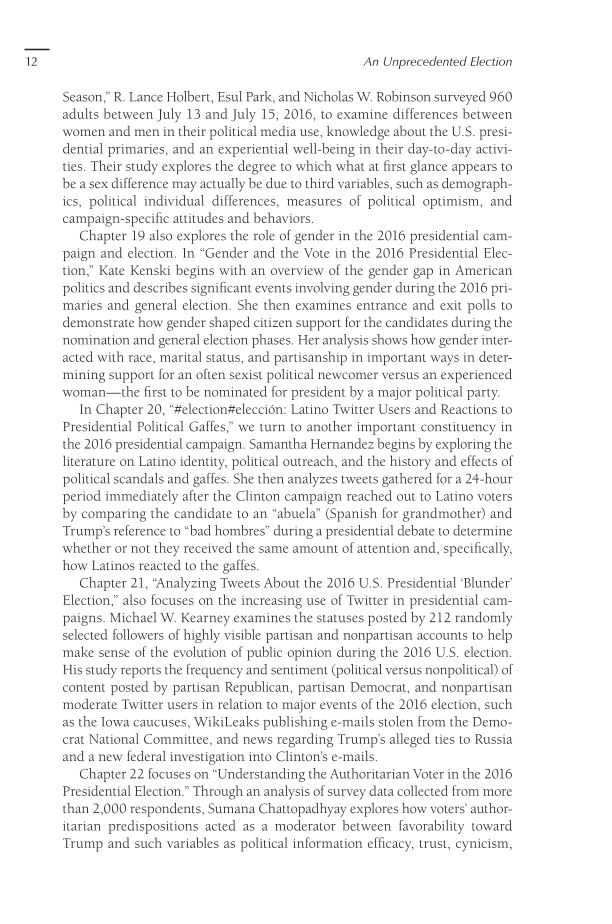12 An Unprecedented Election Season,” R. Lance Holbert, Esul Park, and Nicholas W. Robinson surveyed 960 adults between July 13 and July 15, 2016, to examine differences between women and men in their political media use, knowledge about the U.S. presi- dential primaries, and an experiential well-being in their day-to-day activi- ties. Their study explores the degree to which what at first glance appears to be a sex difference may actually be due to third variables, such as demograph- ics, political individual differences, measures of political optimism, and campaign-specific attitudes and behaviors. Chapter 19 also explores the role of gender in the 2016 presidential cam- paign and election. In “Gender and the Vote in the 2016 Presidential Elec- tion,” Kate Kenski begins with an overview of the gender gap in American politics and describes significant events involving gender during the 2016 pri- maries and general election. She then examines entrance and exit polls to demonstrate how gender shaped citizen support for the candidates during the nomination and general election phases. Her analysis shows how gender inter- acted with race, marital status, and partisanship in important ways in deter- mining support for an often sexist political newcomer versus an experienced woman—the first to be nominated for president by a major political party. In Chapter 20, “#election#elección: Latino Twitter Users and Reactions to Presidential Political Gaffes,” we turn to another important constituency in the 2016 presidential campaign. Samantha Hernandez begins by exploring the lit er a ture on Latino identity, political outreach, and the history and effects of political scandals and gaffes. She then analyzes tweets gathered for a 24-hour period immediately after the Clinton campaign reached out to Latino voters by comparing the candidate to an “abuela” (Spanish for grandmother) and reference to “bad hombres” during a presidential debate to determine Trump’s whether or not they received the same amount of attention and, specifically, how Latinos reacted to the gaffes. Chapter 21, “Analyzing Tweets About the 2016 U.S. Presidential ‘Blunder’ Election,” also focuses on the increasing use of Twitter in presidential cam- paigns. Michael W. Kearney examines the statuses posted by 212 randomly selected followers of highly vis i ble partisan and nonpartisan accounts to help make sense of the evolution of public opinion during the 2016 U.S. election. His study reports the frequency and sentiment (political versus nonpolitical) of content posted by partisan Republican, partisan Democrat, and nonpartisan moderate Twitter users in relation to major events of the 2016 election, such as the Iowa caucuses, WikiLeaks publishing e-mails stolen from the Demo crat National Committee, and news regarding Trump’s alleged ties to Russia and a new federal investigation into Clinton’s e-mails. Chapter 22 focuses on “Understanding the Authoritarian Voter in the 2016 Presidential Election.” Through an analysis of survey data collected from more than 2,000 respondents, Sumana Chattopadhyay explores how voters’ author- itarian predispositions acted as a moderator between favorability toward Trump and such variables as political information efficacy, trust, cynicism,
Document Details My Account Print multiple pages
Print
You have printed 0 times in the last 24 hours.
Your print count will reset on at .
You may print 0 more time(s) before then.
You may print a maximum of 0 pages at a time.









































































































































































































































































































































































































































































